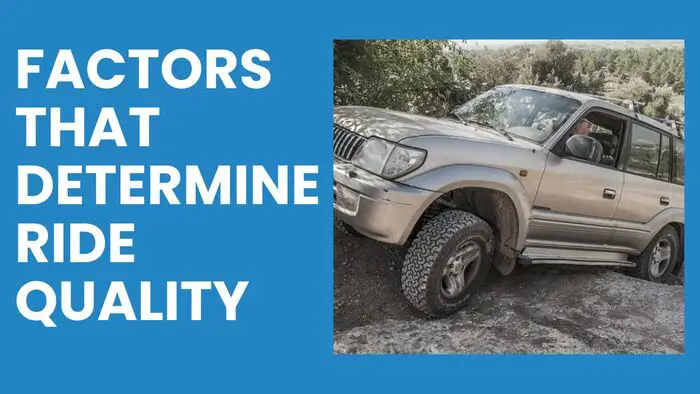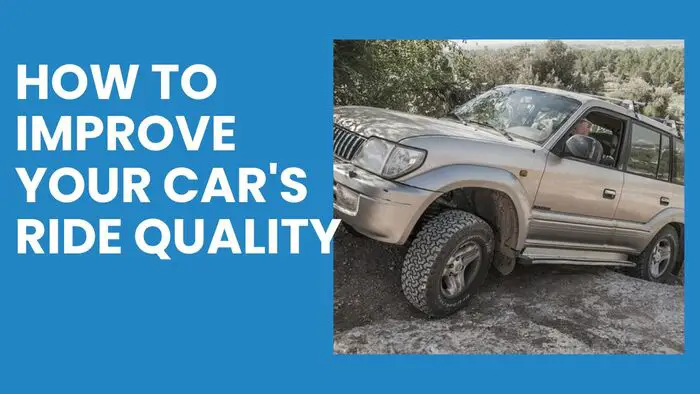For most people, comfort and relaxation are near the top of one of life’s major goals. That could entail anything from earning financial security and taking care of family members to enjoying your free time or finding a comfortable spot to fall asleep at the end of the day.
While you’re quite picky about ensuring your comfort in your daily life, take some time to think about getting cozy and comfortable while driving. After all, your car might be one of those few regions where you spend more time outside your home and workplace.
However, improved ride quality is the key when it comes to comfort while in the car. And it creates a long-tail relationship with your car shocks that can affect your ride quality. When you’re running behind a comfortable ride, get the best shocks for comfort, and your goal will be fulfilled. But why? And how? Let’s see.
What is Ride Quality?

First off, what do you understand by the term “ride quality?” Ride quality, as in things, is perceived differently by different folks. For instance, Nissan-driving folks or a Honda-driving group of friends could each have their own opinion of good ride quality since they will be more accustomed to these types of cars as opposed to someone behind the wheel of a ten-year-old pickup.
It can be technically defined as a vehicle’s ability to bear down on the negative effects of road irregularities on the drivers and passengers and minimize their motions.
Simply put, when the road encounters a pothole or bump, the vehicle should make it through as gently as possible. A succinct explanation, yet a more elaborate process to carry out!
Factors That Determine Ride Quality

The aspects of your driving, such as turning precision, acceleration, and braking, will be influenced greatly by many of the factors that affect your ride quality.
Whatever you choose to prioritize, you can’t ignore all the other elements that impact your driving. It’s most advisable to strive for a good balance of all aspects of driving performance. So, let’s first become acquainted with those influencing factors first.
Suspension system
A suspension system alone will not determine the car’s ride quality, yet it’s an important component for the ride quality of the vehicle. When driving, we go through different levels of vibration frequencies, and their effects are also diverse. To enjoy a comfortable ride, these vibrations need to be isolated.
The high frequencies of vibrations that arise from tire driveline nodes are absorbed by the rubber bushing to which the suspension components are affixed. Every suspension is designed based on some common components, which are springs and dampers.
Technically, the static deflection behavior of the suspension system is a major factor in determining the ride’s comfort. This is because when the spring is deflected, it reacts in various ways based on how far it is compressed. Dampening it to levels that are too high shortens the ride’s quality significantly.
Suspension systems consider many factors, including equipment carrying capacity, weight bias with weights, ride height under loaded weight, along load hip and knee areas of the passengers. Suspension systems aim to attain the best compromise and balance all of these factors.
Wheel Size and Tires
A wheel’s size affects the ride’s smoothness; accordingly, more massive wheels provide a more compliant ride quality as they are more likely than smaller ones to absorb the shock created by bigger bumps and dips.
Wheels that have a smaller diameter will simply sink into large potholes and react violently on wavy surfaces, creating an unpleasant riding experience. Smaller tires increase ride quality and smooth out the ride at the cost of some handling.
Tires with a sufficiently high aspect ratio (on AWD/SUVs) are capable of providing more comfort in general because they can have more of the ability to soak up shocks.
Wheel Alignment and Surface Contact
In most cases, the quality of a ride largely relies on whether or not the wheel alignment is just right. Another factor contributing to the ride quality of a vehicle is how the wheels function over the travel surface. Whether driving over rough terrain, the pressure of the air within tires naturally lowers, leading to misshapen wheels.
Adjusting the tires of a vehicle enables them to remain in good operating condition for much longer. Even a slight plumb will cause a car to pull to the side of the road at moderate speeds. Although this kind of force can make operating a vehicle more dangerous, it causes the ride quality to suffer as well.
Unsprung and Sprung Weight
This variable is also relevant to car wheels. Each car’s mass is measured in two standardized measurements, one that includes structural components of the vehicle, such as a chassis, known as sprung weight.
The other is the unsprung weight, which includes the mass of the components of the vehicle that move them, including suspension, brakes, and wheels. The sprung mass shouldn’t be influenced by road disturbances while driving.
The difference in weight between the sprung mass and unsprung mass also plays a critical role in ride comfort. This is because the execution of higher revolutions and higher speeds makes the suspension more and more subjected to the vertical force acting upon its net mass.
So if you decrease the weight and the amount of unsprung mass, you should significantly increase the ride quality.
Wheelbase and Center of Gravity
Smaller vehicles are inclined to pitch more than large vehicles. At the same time, if a vehicle has a wider track, it will roll less compared to those with narrower tracks.
Besides, the steeple associated with weight distribution also exerts an effect on the passenger’s relaxation as all the forces concerned are thought to be acting through the Center of Gravity. For this reason, you assume that SUV corners feel tighter than sedan laterals.
Why Does Ride Quality Matter For Drivers And Passengers Alike?

People today spend the majority of their time traveling by private or public transport. To ensure that people enjoy the smoothest ride experience possible, the role of improved ride quality is indispensable. Here’s why ride quality matters for drivers and passengers alike.
Ride Quality Ensures Comfort and Driving Safety
The measure of safety offered by different circumstances and vehicle facets, such as the excellent location of road signs and traffic signs, has been grouped under the title “vehicle comfort.” The most stable and comfortable passenger cars have the most secure ride quality. A car that provides a safe ride is also a very convenient vehicle to travel in.
When a vehicle is more comfortable, the driver feels more relaxed and capable of performing at the optimal level, thereby increasing his or her ability to manage the vehicle. The higher the quality of a car, the more solid will control of the driver and thus the less disturbance that is caused on the road.
Improved Ride Quality Provides Healthy Travel
When in a vehicle, the passengers and driver are susceptible to vibrations, noise, accelerations, and other impacts that affect the comfort, activity, and health of the occupants. The frequency, amplitude, duration, direction, and duration of the impact determine the effect of vibration on the human body.
However, prolonged exposure to vibration causes fatigue and distraction for the drivers, reducing their performance and causing anxiety among the passengers. Moreover, riding with extreme vibrations and other impacts can cause health issues.
None of these problems are life-threatening, but they can become more troublesome when they occur repeatedly. For instance, back pain can relate to several health issues. It is often experienced by a large percentage of drivers and passengers and can quickly become considerably worse if it is left untreated.
This can hurt traffic safety, so one of the primary requirements for modern vehicles is to improve ride quality. For this, numerous studies and scientific advancements have been made in recent years to tackle, assess, and comprehend the various ways that affect ride quality.
Improved Ride Quality Means a Fresh Mental Condition
Troubled by your schedule, mood, and the state of your location, traffic on the road can negatively influence your state of mind and thus affect your physical wellness as well. Even a small irritation can become a notable migraine in a place where you have no access to relief.
In that event, ride comfort is crucial for both your physical and mental condition. Since a relaxing environment is conducive to a relaxed state of mind, having a comfortable ride will ease the strain that comes along with driving home from the office or traveling to the shopping locations.
The purpose of a car that offers a modern-day mechanical design and a comfortable driver assistance system is to offer peace of mind while driving.
You can also take charge of the psychological side of the trip by reminding yourself to be mindful of your physical needs, whether taking breaks regularly or stopping to rest for a few minutes during longer journeys.
Prevents Damage
How well the car is braked and accelerated on bad surfaces is directly linked to the ride quality it offers. Improved ride quality prevents the car from shuddering and causing other parts of the automobile to deteriorate. In doing so, it conserves the car as well as its passengers and cargo.
How to Improve Your Car’s Ride Quality

No matter where you live, your car is bound to encounter rough roads. Rough or bumpy roads with potholes, bumps, and cracks can make many drivers uneasy; they are unsure how rough roads affect their car’s long-term performance.
If you want to acquire a smoother, more comfortable trip, here are a few steps you can take to improve the ride quality of your vehicle.
Stay Away from Bigger Wheels
It is not uncommon to see certain cars with gaps around the skinny tire and bigger wheels. Some of these cars’ setups look better, but ultimately, they might not produce the optimum riding experience. This is because thinner treads on the tires can cause a lot of bounces and banging as you drive.
You can make your car aerodynamic by lowering the wheel diameter or adding thicker tires; however, you will need to thin your treads quite a bit to utilize those larger wheels.
Ideally, if you replace the original tires and wheels in your car, you should stick to the default mounting location. This means that you should consider selecting a wheel that’s about one-third of an inch smaller or larger than your go-to product so you don’t end up with unacceptable changes to the car’s ride quality.
Be Cautious While Choosing Tires
Another good thing to help maintain the ride quality of your vehicle is purchasing the proper tires. The first thing you should investigate about tires is that not everyone gets them equally.
You will find specific tires on the market that are engineered for the road, which will have softer rubber to increase the vehicle’s traction, but they will decrease the lifespan of your tires.
Next to this, you’ll see touring tires. These tires fall under the context of trailers for those driving on paved roads where speed does not exceed 75 mph. Also referred to as temporary tires, touring tires offer a variety of advantages, including reduced harshness of road riding, extended last, and high fuel efficiency.
Touring and performance tires are both lucrative tire alternatives. An element of both worlds can be found in, say, a wordy and tenacious segment of tire that is created to keep people safe and the environment pure.
Thinking back to the differences and similarities between these machetes and the types of novelty tires, it is critical to recognize the qualities of a tire today.
Tune Suspension and Wheel Alignment
Your vehicle’s suspension components may feel out of place as your body’s impact absorbs sharper impacts throughout your journey. Being able to tell that the suspension geometry may not be ideal over time is a telling indication of the fact that your car’s suspension system might need work.
If you want your car to be repaired and ensure that your suspension is working properly, bring it to a car maintenance or repair facility or a suspension specialist. If you’re driving a car made with modifications like wider and bigger wheels or an upgraded suspension, then it may be a good idea to have your tires aligned and adjusted.
Repair or Swap Your Suspension Out
A high point of ride quality is your suspension, but substituting suspension components is certainly not as straightforward as changing out wheels and tires. Proceed right away to your struts and your shocks should you intend to do any suspension maintenance of your own.
These types of suspension parts are similar in that both shut down jolts from the road and help improve the smoothness of your automobile’s suspension. You’ll have to first recognize the specific kind of suspension found in your vehicle.
As a rule, front-wheel-drive cars and crossovers will have struts in the front and shocks in the rear. Once you have noticed that your car is a little bouncy, it might be time to check your struts and shocks, which are the leading cause of bouncy rides.
Best Shocks For Comfort
Even the most durable shock absorbers deteriorate over time. It’s assumed that one of the most common repairs and alterations for a faulty suspension system is to purchase new shocks. And when it’s about ensuring ride comfort, you have to be more specific and choose the best shocks for comfort.
A good rule of thumb here is to pick shocks that resemble your factory suspension tuning and perform almost near to these. In this case, the KYB Excel-G Series, Monroe OESpectrum, and Bilstein B4 series would be some of the best options so far.
Final Words
At this point, you might have understood how important ride quality is for every driver and passenger. Being certain of this fact, you might not leave any opportunity to infuse “comfort” in your ride.
Grab the best shocks for comfort, get the suspension tuned, and maintain ride height, wheel size, and tires. You’re all set to reap the maximum benefits of improved ride quality in every phase of your journey.